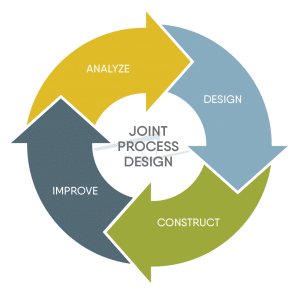What is a JPD? Using Joint Process Design in Software Implementation Methodology

JPD (pronounced JAY-pod) – an acronym for Joint Process Design which is a working session during an implementation where we (the consultants) work jointly with our client to design how the new ERP solution will handle a specific process.
If you have ever had to provide a list of requirements for a new piece of software or functionality, you know how difficult of a task that can be. Usually, you will start out strong with a list of all the requirements that will hopefully fix the frustrations or pain-points you have with your current system. Then you’ll list the basic functionality that it needs to support so that you can continue to do your day-to-day tasks. Eventually, your mind starts to go blank and you realize that starting with a blank piece of paper (or Excel workbook) and trying to capture all of your needs isn’t as easy as you thought it might be. After thinking through everything you’ve done in the last couple of weeks and writing down a few more requirements you decide that you’ve captured the majority of the requirements and anything you missed is probably pretty small so you hand off your list to the designer/consultant.
What is generally forgotten is the fact that each person who looks at the list of requirements is looking at it from a different perspective. When you write a requirement like “Must be able to send a credit to a customer”, you are thinking about it from the perspective of how you have always done it. While the consultant who looks at it will think about how the new system handles it and will determine that the requirement is met. However, once you receive the final solution, it may be completely different than what you were expecting. The other problem that occurs quite often is that there are generally a lot of assumptions made about basic functionality that you just expect the system to be able to handle and then later find out that it doesn’t.
JPD's are Process Centric
We at Stoneridge Software have recognized these issues and have come up with a methodology that is process centric. This process centric approach relies heavily on the JPD sessions. Instead of asking you what requirements you have for your new ERP system and asking you to tell us how you want the system to work, we conduct JPDs with your subject matter experts. During the JPD, we will ask what processes (like Manage Customer Master or Send Credit to Customer) need to be handled by the new system, find out the steps you go through currently to complete each of those processes, and then find out what steps have pain-points in them and what you would like the new system to be able to do to handle those pain-points better. Understanding that coming up with a list of processes from scratch is not much easier than a list of requirements, we also come into the JPD session with a list of standard processes to help guide the conversation and provide you with a starting point.
JPD's Using Multiple Iterations
Now, you may be wondering “where does Design come into this”? Well, we actually go through multiple iterations of JPDs for a single group of related processes. The first iteration, as described above, is more of an interview process where we are getting to know your business. The following iterations we actually show you how we are proposing your processes will fit within the new system. This gives you an opportunity to see the new system, begin getting familiar with how it works, and provide feedback early on in the implementation of what will work for you and what won’t. Also, as we go through additional iterations, you begin thinking of other scenarios that you had forgotten about initially and we are able to add those to do the design and show you how they fit.
JPD's Help You Own the Final Solution
Using this methodology, we are able to use our expertise of the system and your expertise of your business to work together and come up with a solution that fits your needs. This also allows you to own the final solution and to understand the reasoning behind the different design decisions. Finally, it allows us all to focus on coming up with a solution that handles your business processes rather than just meets requirements that may or may not have been interpreted correctly and may not fit well together in the final solution.
If you are interested in finding out more information about our implementation methodology, please visit our website and go to our Methodology page found here.
Under the terms of this license, you are authorized to share and redistribute the content across various mediums, subject to adherence to the specified conditions: you must provide proper attribution to Stoneridge as the original creator in a manner that does not imply their endorsement of your use, the material is to be utilized solely for non-commercial purposes, and alterations, modifications, or derivative works based on the original material are strictly prohibited.
Responsibility rests with the licensee to ensure that their use of the material does not violate any other rights.
